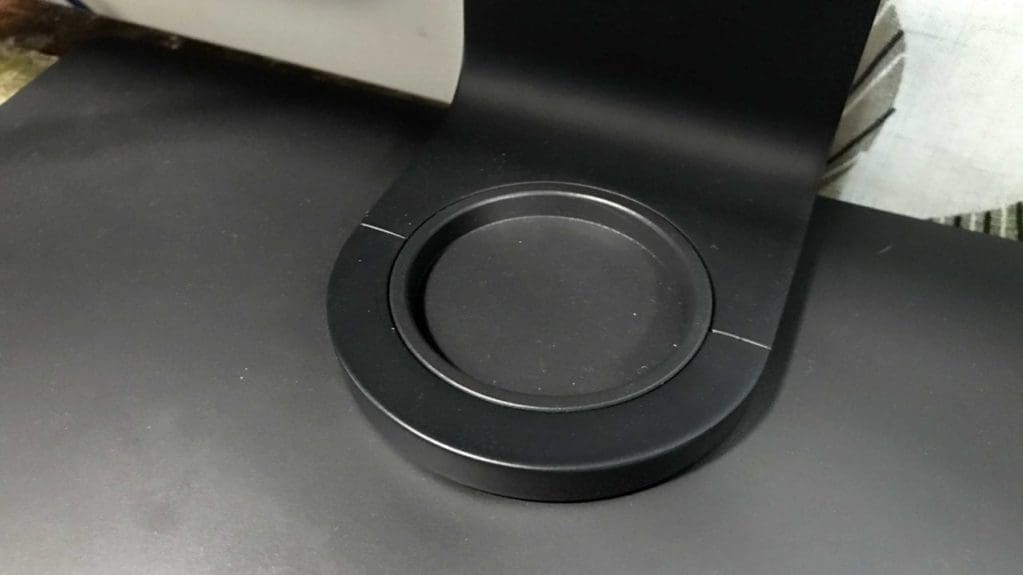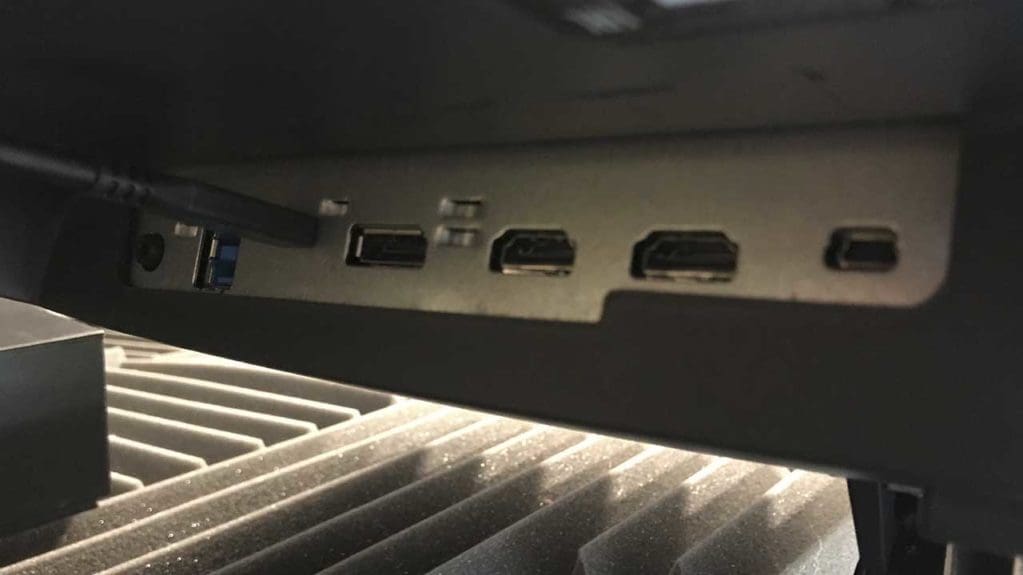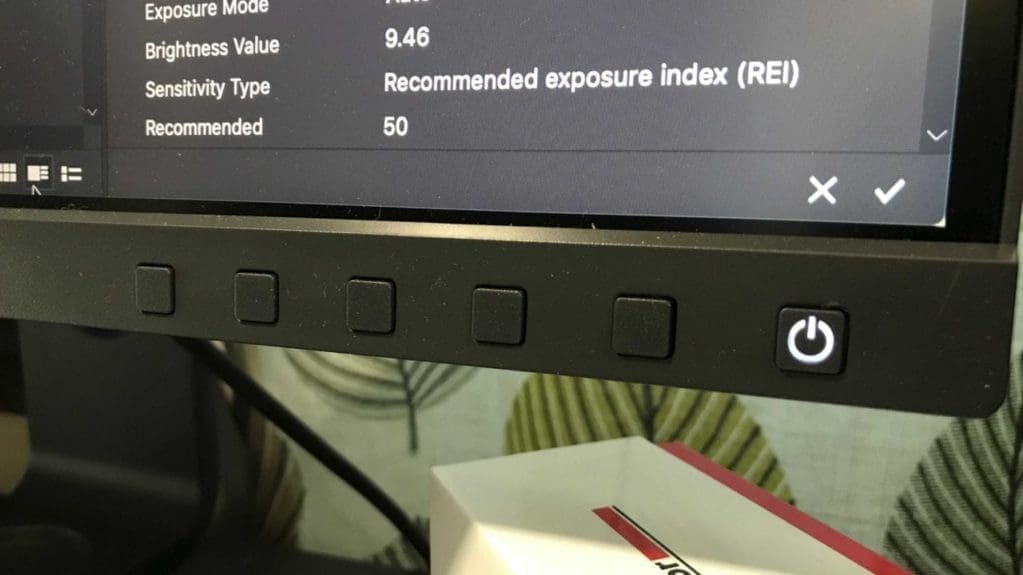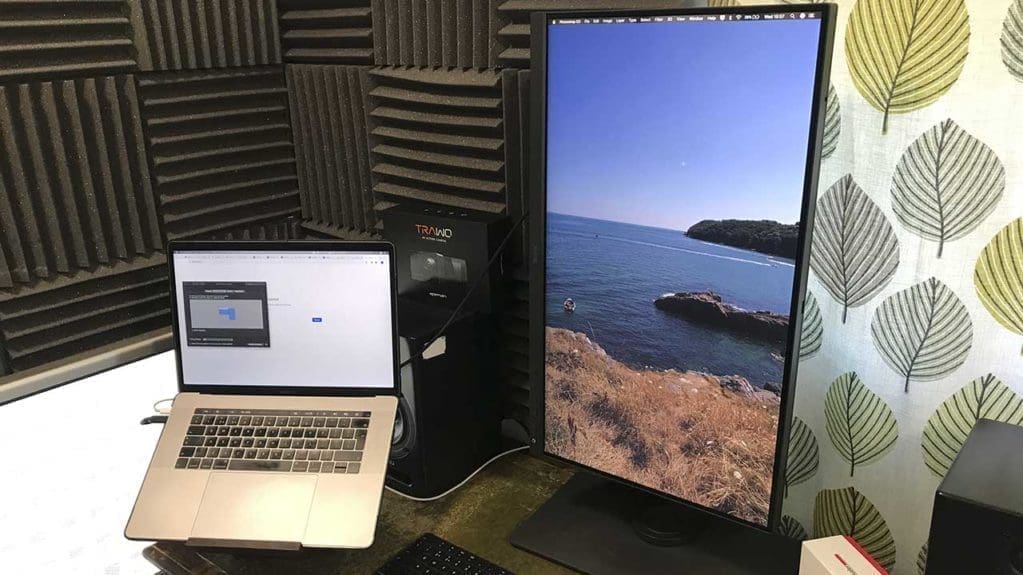I love a big monitor, one that enables me to see video at a decent resolution and images larger than life. The BenQ SW271 is just large enough at 27-inches and features a resolution of 3840 x 2160 UHD.
From the outset, the build quality is solid with a well-finished exterior that makes it feel like a real step up from mainstream monitors.
The set-up is quick and easy and using the DataColor SpyderX the monitor is quickly calibrated to suit the conditions of the office.
Colour and tone when checked are even across the screen and images look balanced and as they should.
This is, however, a monitor with a price tag just shy of £1000 so you’d expect quality, features and function.
The SW271 is stylish and functional, a workhorse in the professional studio. It has features that make it shine out, and some peculiarities like the Puck that some users will love and others will leave wrapped and in the box.
For the price, it’s a good value; actually, it’s a great value. The resolution of this monitor is pretty much unmatched by EIZO and NEC when it comes to graphics monitors.
If you need a monitor that displays at this resolution, then the SW271 dominates as the only real option in this area of the imaging market.
Introduction
BenQ is steadily increasing its dominance in the market, producing quality well-priced monitors.

The pro-SW range has already impressed us here at camerajabber.com when we looked at the huge SW320. The SW271 follows much the same storyline; it’s a stylishly designed workhorse that packs in the specifications that few other manufacturers can match.
The fact that this is a sub £1000 monitor that displays 3840 x 2160 UHD is amazing, the fact that it does it with such quality without cutting corners is unheard of.
BenQ has come a long way. In the past when I looked at some of their early monitors the build quality wasn’t always there, although the design and build were always carefully considered.
But, now with the SW271 in front of me, it shows the BenQ has really upped the game if the price tag had been £1500 I would have thought expensive for the brand, but about right for the quality and specifications. At £1000 and looking at what you get it seems like a bargain.
Features
For £1000, or a little less, you expect quite a bit from a monitor. Or at least you would if it wasn’t for the fact that this is a dedicated creative monitor and those usually weald a hefty price tag.

The SW271 is expensive for a BenQ monitor and a 27-inch. I’m sure I saw a 27-inch monitor in the supermarket last week for less than £200, so why you may ask pay more?
There’s a lot of hidden technology packed inside the screen, and although all monitors do roughly the same job, it all comes down to accuracy, illumination and resolution.
When it comes to imaging, you need accuracy, so you know that the images or video your enhancing will look as good on a print, TV or other output as it did on your screen.
The main features of the BenQ SW271 are the 27-inch screen size, 4K UHD (3840×2160) resolution, 99% Adobe RGB Color Space with IPS technology.
IPS is now the standard for any monitor that you buy for imaging and this one uses backlight LED technology with a brightness of 350, a contrast ratio of 1000:1 viewing angle of 178/178 and refresh rate of 60Hz making it ideal for video production as well as stills.
The aspect ratio is 16:9 which is standard since the change from 4:3 standard a few years ago, and the display will show 1.07 billion colours.
Colour Gaut is 99% AdobeRGB and 100%sRGB and there’s plenty of adjustment over the usual parameters such as brightness, colour, hue etc.
As standard, there’s a selection of colour modes that can be selected using the on-screen displays accessed through the buttons on the monitor, or short keyed to the Puck.
These modes include the usual selection alongside Rec 709 for video editing, custom configs, HDR to melt your eyes and a very impressive B&W workspace.
This monitor is directly aimed at imaging Pro’s, and a nice feature here is that BenQ has ensured that they’ve included many of the items that pros are used to seeing when they buy a new monitor.
Inside the box is the factory calibration report, and as standard, the monitor has 3D-LUT, Delta E, Hardware calibration, video support, Gamut duo, a darkroom mode, white point and black level and the puck.
The puck looks like a puck and features hotkeys that enable you to swap between colour modes as you need. It’s a nice feature, but another piece of kit, although small, that will clutter up your desktop.
Monitors as USB hubs is now a standard feature and the SW271 has a fair amount of ports.
2 x USB downstream and 1 X USB Upstream, there’s USB Type-C, display port, HDMI, 3.5mm audio and an SD card reader.
Physical dimensions for the size make the monitor nice and slender at 504mm (stand low) 614mm (stand high) x 626mm x 334mm withstand. The entire weight is 16.4kg so nice and weighty.
The stand enables plenty of flexibility with a tilt of -5/20º, the swivel of 45/45º and pivot of 90º. The stand height adjustment is a full 150mm which is quite a bit.
The monitor has been designed for use on both Mac and PC systems as long as they have the right connectors.
Build quality and handling
From the outset the quality of the BenQ monitor is apparent. The plastic outer is well finished and feels of high quality, then there are the lines of the design which are slender and stylish.

Once the stand is bolted on to the weighted base and stood on the desktop, the monitor can be clicked in place using the slick, quick release system.
Construction takes a couple of minutes in the worst case, and there’s nothing fiddly.
Then before plugging in power and connecting through USB Type-C to the computer the hood and puck can be attached.
The hood quickly clips into place, in the test I chose not to use this, as there are no lighting distractions that fall into the office, it’s just me, and the office is North facing by design.
The puck plugs into the back of the monitor, and I’m set to power up.
Out of the box, the monitors colour and tone looks fine, but as ever I know that even under my daylight balanced office lighting there’s going to be a slight colour balance issue.
But, before plugging in the monitor calibration, BenQ has its own Palette Master Element Calibration software. Used in conjunction with your monitor calibrator you can then fine-tune your monitor’s performance.
The software seems relatively basic compared with Eizo’s ColorNavigator, but that’s not to say it’s lacking. As a software solution it’s well thought out but where it excels is with its compatibility with X-Rite and DataColor calibrators.
Plugin your calibrator and you can then calibrate and save your profile.
One feature that I’m starting to see on a few monitors is the ability to save that calibration to the monitor’s hardware rather than the computer. This means that it’s the monitor that’s calibrated and not the machine.
This is especially useful if like me you use a MacBook in and out of the office. It means that I can have my office calibration and then when I step out I can switch to a more generic calibration and then return I can plug into the monitor and it will still be correct, even if I forget to switch the calibration.
Another nifty device is the puck; this enables you to quickly switch between colour modes. During the test, I went through periods of liking the idea of it and then getting frustrated with the additional wires and losing the puck down the back of the desk.
Once calibration is out of the way, and I’ve tuned my video, stills, document and kicking back and watching TV profiles, I set to work.
As ever a testament to a good device is that it seamlessly integrates with your daily life. The 27-inch monitor is smaller than the 32-inch I’m used too, and that reduction in screen real estate was felt, and I did feel I needed a second monitor.
However, it wasn’t a huge issue and the MacBook Pro monitor fitted the bill. I’m getting used to the smaller screens having switched from one 27-inch to another in recent months.
In use, the monitor is excellent and the benefits of the additional resolution were instantly felt.
Accuracy seemed good for colour, tone and contrast and using the puck when it hadn’t fallen down the back of the desk was useful.
Checking accuracy
I used the DataColor SpyderX Elite Display Analysis tool to check out how the monitor performed.
After running the tests, it showed the following results:
- Gamut: 5 / 5
- Tone Response: 4 / 5
- White point: 3 / 5
- Contrast: 5 / 5
- Luminance Uniformity: 4.5 / 5
- Color Uniformity: 4.5 / 5
- Color Accuracy: 4 / 5
- Overall rating: 4.5 / 5
The results were impressive showing excellent screen uniformity, colour, tone and contrast. These results indicated that when it came to the quality of the image, it beat the larger SW320.
Verdict
27-inches has now become the standard size for many imaging professionals. It balances size with price and leaves you some space on your desktop for a keyboard, mouse tablet and Pallet Gear if you need.

The design is sleek fitting into any office nicely, and the added features pitch this well above its rivals.
Although I only briefly added the hood it’s an essential feature and can be a costly aftermarket addition, so to have it in the box is a bonus.
The puck is a nice idea, but I’m not tidy enough to make full use of it, and it spent a large proportion of the month down the back of the desk swinging from its cable.
The Palette Master software and integration with the DataColor Monitor calibrators boosted an already comprehensive monitor solution.
I’m a great believer of a dual or tri monitor set-up, and as a primary central monitor, the SW271 is hard to fault. I need to find two identical looking monitors at a fraction of the price to sit either side.
If you need a monitor for serious visual work then the resolution, size and price now elevate this to my number 1 choice.



